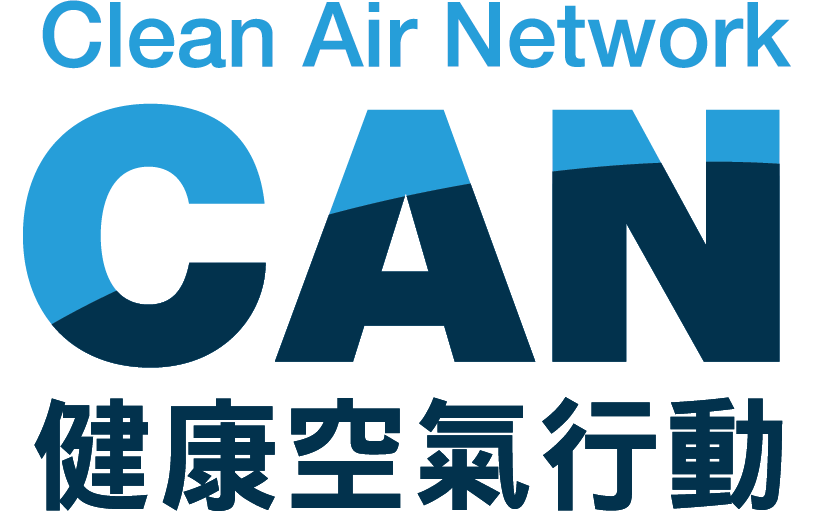
Air Monitoring Report of Tuen Mun – ‘Let Our Children Breathe’
BACKGROUND
Clean Air Network launched ‘Let Our Children Breathe’ Campaign to conduct a series of air monitoring activities in the Tuen Mun District. This report reflects the result of monitoring conducted during 18th January to 31st January 2021.
One surrogate air pollutant (nitrogen dioxide, NO2) is used to reflect the level of street level air quality. Concentrations of the pollutant were measured at 50 monitoring spots located in Tuen Mun to understand the roadside air pollution the community is exposed to.

Photo 1: Patrick Fung, Chief Executive Officer of the Clean Air Network (first from the right), Mr. Ho, Head of Liberal Studies from the Church of Christ in China Tam Lee Lai Fun Memorial Secondary School (first from the left) and students and elderly volunteers were holding NO2 tubes to demonstrate how NGO, schools and citizens can work together to monitor and improve air quality
Summary
- Among the 50 monitoring spots, the 10 most polluted spots with the highest concentrations of NO2 include bus stops, light rail stops and school zones which are near busy roads.
- The 3 most polluted bus stops are also the first, second and fourth spots recorded the highest concentrations of NO2 in Tuen Mun. These bus stops are with cover or semi-confined so pollutants are difficult to be dispersed, threatening the health of the citizens.
- The 3 most polluted school zones are close to busy roads, one of the school entrances is less than 10 meters away from the traffic. There is an urgent need for the government to install air filters and screen for schools exposed to serious air pollution.
Note
Due to limitations of the equipment, in this report we will focus on the relative comparison of pollution level among all monitoring spots. The absolute level of the monitoring result of this study is for reference.
Monitoring Location
Image 1:50 monitoring locations
Link: https://cutt.ly/Bxc837c

Image 2: Categories of 50 monitoring spots
| Category | Quantity |
| School zone | 15 |
| Bus stop | 12 |
| Park/Playground | 12 |
| Light rail stop | 10 |
| EPD Tuen Mun Air Quality Monitoring Station | 1 |
ANALYSIS
Methodology of Analysis
- Average concentration level is used to describe and compare the air pollutant levels among the selected locations.
- Observation on surrounding environment was conducted to identify possible factors of influence of the level of pollution at all spots.
Result of Analysis
1. The 10 most polluted spots are mainly close to Tuen Mun Road
Image 3: 10 monitoring spots with the highest NO2 concentration
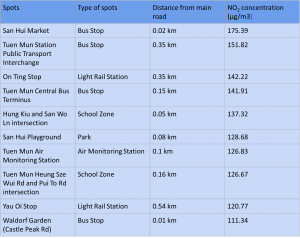
From the above table, we can observe that most of the spots are located quite close to main road (Tuen Mun Road), which is the most congested road in Tuen Mun. The air pollutants from the traffic road directly affect the air quality and worsen the air pollution problem in the spots. When compared with spots which are far away from the main road, we can observe that the NO2 concentration exceed a lot. It proves that the distance from the main road will directly affect the NO2 concentration in the spots.
According to Environmental Protection Department (EPD), the past 24 hours pollutants concentration of NO2 is around 60 µg/m3, which is far less than our measurement. This is because the air monitoring station is built 27 meters above ground, while our NO2 tubes are installed nearby the bus stop. Thus, the data from the Air Monitoring Station hardly reflects the NO2 exposure of the pedestrians.
2. The 3 most polluted bus stops are all covered or semi-confined
Among the 12 bus stops we monitored, the 3 stops with the highest NO2 concentrations are below:
Image 4 & 5: 3 bus stops with the highest NO2 concentrations
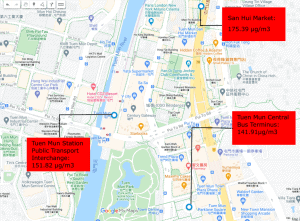

The 3 most polluted bus stops are also the first, second and fourth spots recorded the highest concentrations of NO2 in Tuen Mun. They are with cover or semi-enclosed so pollutants are difficult to be dispersed, threatening the health of the citizens.
San Hui Market bus stop is located in Tuen Mun Road, with a daily traffic of 127,870. Tuen Mun Road is a traffic highway, with the design of noise barrier to mitigate the noise pollution.
However, the noise barrier will trap the air pollutants, so the NO2 pollution remains high in the bus stop. This will seriously affect the health of the passengers, as passengers are constantly breathing in air pollutants while waiting for bus.
Image 6: San Hui Market bus stop
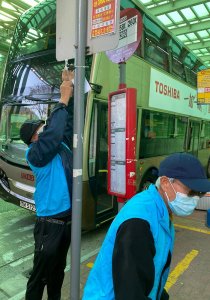
Tuen Mun Station Public Transport Interchange and Tuen Mun Central Bus Terminus are covered bus terminus with superstructure. Bus terminus should strictly follow the emission stated in the “Control of Air Pollution in Semi-confined Public Transport Interchanges”. However, since it has no legal validity, bus companies have no responsibility to follow the practice note.
On the other hand, covered bus terminus are usually designed without ventilated corridor, which traps the air pollutants and increase the NO2 concentration.
Furthermore, buses may be unable to drive away in busy hours, idling for a longer time in the terminus. Therefore, children, or even adults waiting at the terminus waiting for bus will expose to more NO2, posing to more harms to health.
3. The 3 most polluted school zones
Among the 15 school zones we monitored, the 3 stops with the highest NO2 concentrations are below:
Image 7 & 8: 3 school zones with the highest NO2 concentrations
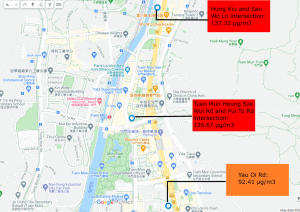

High concentration of NO2 are normally found near to street with high traffic flow, which can be measured in terms of Annual Average Daily Traffic (AADT) data.
For instance, the school zones in Hung Kiu and San Wo Ln intersection, and Tuen Mun Heung Sze Wui Road and Pui To Road intersection are located near Tuen Mun Road, the most congested road in Tuen Mun.
According to AADT 2019, Tuen Mun Road (from Pui To Road to Tsing Chui Path) resulted in a daily traffic of 127,870, while Tuen Mun Road (from Wong Chu Road to Tuen Hing Road) resulted in a daily traffic of 102,060, far more than the traffic in other roads in Tuen Mun.
This explains why the NO2 pollution in these two schools are serious.
Since children’s organ are still developing, they are under higher risk of having respiratory diseases. Thus, we suggest children to choose a route with better air quality, to reduce the exposure to NO2 pollution.
Image 9: the junction of Tuen Mun Heung Sze Wui Rd and Pui To Rd
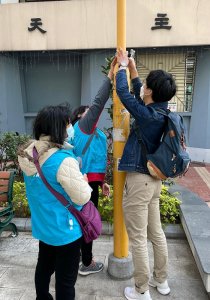
Although the daily traffic of the school zone in the junction of Tuen Mun Heung Sze Wui Rd and Pui To Rd are far less than the Tuen Mun Rd, the school is next to Tuen Mun Station Public Transport Interchange, one of the most polluted spots in this 6-weeks measurement period. On the other hand, the main entrance of the school is facing the road, less than 10 meters away from the traffic, contributing to the high NO2 concentration and increases the health risk of children.
4. The 3 most polluted light rail stops
Among the 10 light rail stops we monitored, the 3 stops with the highest NO2 concentrations are below:
Image 10 & 11: 3 light rail stops with the highest NO2 concentrations
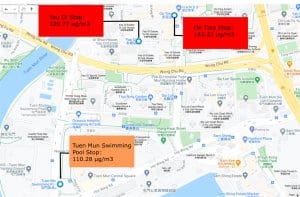

Image 12: On Ting Stop
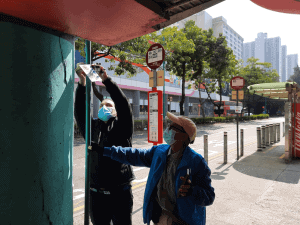
Although the most polluted light rail stops are located far away from Tuen Mun Road, they still result in a high NO2 concentration.
On Ting Stop is located beside the bus stop. The bus idling directly affects the air quality in the light rail station. Furthermore, the light rail station and bus stops are covered by the bridges of the nearby shopping mall, and the air pollutants hardly disperse. This contributes to the high NO2 concentration in the light rail station.
For Yau Oi Stop, it is surrounded by the traffic highway Wong Chu Road, and Tuen Mun Heung Sze Wui Road. According to AADT 2019, Wong Chu Road (from Tuen Mun Road to Hoi Wong Road) has a daily traffic of 53,510, half of that of Tuen Mun Road. The heavy traffic increases vehicular emission and degrades air quality.
With the KMB and Citybus depot surrounded, the NO2 concentration in Tuen Mun Swimming Pool stop is quite high. Buses entering and leaving the depot will continuously emit air pollutants and pollute the surrounding environment. Therefore, the NO2 concentration in morning and night times are extremely high.
5. The 3 most polluted parks/playgrounds
Among the 12 parks/playgrounds we monitored, the 3 spots with the highest NO2 concentrations are below:
Image 13 & 14: 3 light rail stops with the highest NO2 concentrations
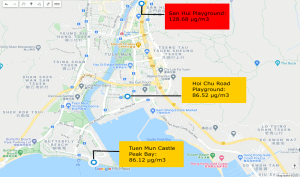

Image 15: Tuen Mun Castle Peak Bay
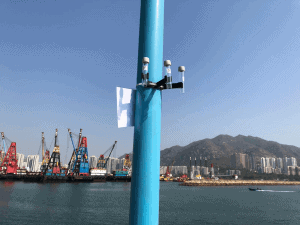
Comparing with the measurement of other locations, we have found that parks generally have lower NO2 concentration. Yet, when compared with the previous NO2 measurement in Sham Shui Po, the NO2 concentration in Tuen Mun parks are still exceeding a lot.
With the short distance from Tuen Mun Road, San Hui Playground have an extremely high NO2 concentration. At the same time, San Hui Playground lacks ventilation system and noise barrier to blow away air pollutants. Staying in the park for a long period of time will pose serious health impacts to children, such as worsening their respiratory diseases. Therefore, children are not advised to stay in this park.
On the other hand, Hoi Chu Road Playground is located near Yau Oi (South) bus terminus, one of the most polluted bus stops in this measurement. Buses idling in the bus terminus constantly emit NO2, and directly affect the air quality in the playground.
With Tuen Mun Pier nearby, the NO2 pollution in Castle Peak Bay mainly comes from ship emission. Shipping industry accounts to 37% of NO2 concentration in Hong Kong, according to the Environmental Protection Department. This emphasises that ship emission greatly affects the air quality in the Castle Peak Bay.
Policy Recommendations
1. Source control: accelerate transition to zero emission vehicles
Exhaust from commercial vehicles (CV) and public transport (PT) account for over 90% of roadside air pollution. Transformation of CV and PT to zero emission mode will minimize the road transport emission, reduce the level of roadside air pollution and thus reduce the overall public health costs.
It is recommended for the Government to strategize to accelerate transformation of CV and PT to zero emission mode. Specifically, the Government should establish an infrastructure development goal, develop funding model to narrow the gap on purchasing newer energy vehicles, and to re-energize the Steering Committee on the Promotion of Electric Vehicles to provide high-level coordination among Government bureaus and departments.

Photo 2: Patrick Fung, Chief Executive Officer of the Clean Air Network hopes the government can reduce air pollution from the source by transforming all vehicles to zero emission.
2. Regular monitoring and reporting to inform decision making: expand the scope of Green Schools initiative
Enhanced monitoring and reporting mechanism will help to inform decision makers of the school bodies and Government to introduce appropriate measures.
CAN recommends the Government to expand the scope of Green Schools initiative to subsidize schools to conduct air pollution audits and implement regular monitoring and reporting system.
An expanded Green Schools initiative will also close the financial gaps for schools to implement measures, such as to enhance ventilation system, install barriers, filters and purifiers.
3. Focus to protect schools and elderly homes: assess health risk exposed by the children and elderly across the territory
According to Hong Kong Planning Standards and Guidelines of the Planning Department, there are some recommended buffer distances for trunk roads, primary distributors and other road networks. However, there is no recommended buffer distances between any road networks and school, kindergarten and elderly home while children and the elderly are the most sensitive and vulnerable groups among us.
The Government should review the planning guidelines and examine the number of facilities of vulnerable groups are located near busy roads. The Government should also enable the construction of barriers between main traffic road and schools and elderly homes.
4. Tighten standard and control of semi-confined bus stops air quality control of semi-confined bus stops
The Practice Note on Control of Air Pollution in Semi-confined Public Transport Interchanges issued by the Environmental Protection Department (EPD) in 1998, provides guidelines on the air quality of semi-confined public transport interchanges (PTIs). However the Practice Note is not legally binding. Bus operators do not have any incentives to improve the air quality of the bus stops. Even for those PTIs managed by Transport Department (TD), the air quality is not constantly monitored. TD commissions the Electrical and Mechanical Services Department (EMSD) to conduct air quality measurements in the covered PTIs only every two years.
We urge the government to tighten the standard and control of air quality of semi-confined PTIs; and enhance monitoring and report mechanism to inform citizens on the real-time air pollution level in PTIs; tighten standards of ventilation systems of all PTIs to reduce level of pollution exposed by commuters.
Sharing from ‘Let Our Children Breathe’ partners
The Church of Christ in China Tam Lee Lai Fun Memorial Secondary School is one of the schools participating in ‘Let Our Children Breathe’ Campaign. Mr. Ho, the Head of Liberal Studies said that TLLF is not only affected by the roadside pollution from Tuen Mun Road but also exposed to the unpleasant smell of Tuen Mun River. He hopes that the government can set up a ‘Campus Air Index’ and work with schools to improve their air quality in order to build a clean and comfortable environment for students to study.

Photo 3: Patrick Fung, Chief Executive Officer of the Clean Air Network (left) and Mr. Ho from the Church of Christ in China Tam Lee Lai Fun Memorial Secondary School (right) discussed the air quality of the campus.

Photo 4: Students and elderly volunteers demonstrated the installation of NO2 tubes
About ‘Let Our Children Breathe’
Starting from summer 2019, CAN has launched ‘Let Our Children Breathe’ Campaign, which is a community education pilot program aiming to identify the level of air pollution exposed in school area and raise public awareness on the links between exposure to polluted air and its adverse health effects in children. Sponsored by Tuen Mun District Council, ‘Let Our Children Breathe’ Campaign conducted an air monitoring project in Tuen Mun this year to measure the air pollution in the community.
